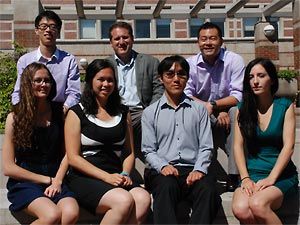Applied Mathematics Students Present Project to USC Shoah Foundation
Staff and faculty at USC Shoah Foundation gathered Wednesday to view this year’s project from the 2013 UCLA Institute for Pure and Applied Mathematics (IPAM)’s Research in Industrial Projects (RIPS) program.
RIPS brings together groups of applied mathematics students from around the world for 9 weeks each summer and assigns them to sponsor organizations such as IBM, Intel, Standard and Poor and the Los Angeles Police Department. The sponsor provides an applied mathematics problem within their organization and the students are tasked with finding a potential solution. This is the third year USC Shoah Foundation has participated.

Amanda Bower (University of Michigan, Dearborn), Alice Dilanchian (UC Berkeley), Mihaela Turcu (Jacobs University, Bremen, Germany) and Feng Zhu (Princeton University) were assigned to USC Shoah Foundation’s technology department, which asked the team to evaluate the effectiveness of the Visual History Archive’s Quick Search function and propose a new model that would yield more relevant results. Quick Search allows users to enter keywords and then provides testimonies with segments that match those keywords.
The Visual History Archive allows users at access sites to search through and view nearly 52,000 audiovisual testimonies of survivors and witnesses of the Holocaust and other genocides. These testimonies were conducted in 57 countries and in 33 languages. The Visual History Archive Online contains 1,200 testimonies for the public to view.
During their presentation, the group noted that the current Quick Search provides search results alphabetically by the interviewees’ last names, which is not helpful for users looking for the segments that are most relevant to their queries. Users tend to view the testimonies displayed at the top of the results list, as well as the first segment of those testimonies, much more than any other results, even though this may not be what they were looking for.
The group used algebraic and feature-based retrieval models to come up with a ranking system that would yield search results deemed more relevant to queries. To test their model, the group asked fellow RIPS participants to compare sets of testimonies yielded from the current Quick Search model and their new model, and decide which they preferred to watch. The group found that 80 percent of respondents chose the testimonies obtained from the RIPS model over the current model.
In order to improve Quick Search further, the group recommended that USC Shoah Foundation experiment with personalized search capabilities, which would give users results based on their previous viewing habits; a recommendation system so users could recommend particularly useful testimonies to others; or gather explicit feedback from users describing their experience using Quick Search.
USC Shoah Foundation will keep the group’s research, data and final report and may implement some of the project into the Visual History Archive in the future.
“Each year I’m very impressed by the enthusiastic readiness of our teams to dive into the problems we present,” said Leo Hsu, USC Shoah Foundation programmer analyst. “The results of our team’s research this year will definitely influence how we present search results in the Visual History Archive and Visual History Archive Online in future versions to provide the most relevant results to our users.”